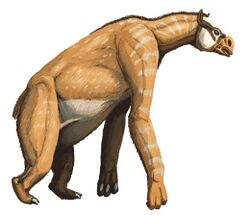Biology:Chalicotheriinae
| Chalicotheriinae | |
|---|---|

| |
| Anisodon grande, formerly Chalicotherium grande | |
| Scientific classification | |
| Domain: | Eukaryota |
| Kingdom: | Animalia |
| Phylum: | Chordata |
| Class: | Mammalia |
| Order: | Perissodactyla |
| Family: | †Chalicotheriidae |
| Subfamily: | †Chalicotheriinae Holland and Peterson, 1914 |
| Genera | |
| |
Chalicotheriines are one of the two subfamilies of the extinct family Chalicotheriidae, a group of herbivorous, odd-toed ungulate (perissodactyl) mammals that lived from the Eocene to the Pleistocene. The other subfamily is the Schizotheriinae. Chalcotheriines evolved unique characteristics for ungulates, with very long forelimbs, short hindlimbs, and a relatively gorilla-like physique, including knuckle-walking on their flexible forelimbs, which bore long curved claws. Members of this subfamily possessed some of the longest forelimbs and shortest hindlimbs in relation to each other out of all extinct animals. Analysis of dental wear implies that most chalicotheriines fed on seeds and fruit. Their claws were likely used in a hook-like manner to pull down branches, suggesting they lived as bipedal browsers.[1]
Presence of chalicothere fossils is generally regarded as an indicator of forested environments. Unlike schizotheriines, chalicotheriines were typically confined to moist forests with a full tree canopy, and their lower-crowned teeth indicate a softer diet.[2] While their appearance may look odd for an ungulate with a horse-like head, similar forms have evolved repeatedly in unrelated lineages: large herbivores that feed as bipedal browsers, standing or sitting upright and pulling down branches or stripping vegetation with clawed forelimbs. Examples include therizinosaurs, the pantodont Barylambda, homalodotheres, and megatheriid ground sloths. Anisodon shows ischial callosities on the pelvis, a characteristic adaptation for sitting for long periods of time. Chalicotheriines are likely to have diverged as specialist feeders sitting in lush forests, similar to modern gorillas and giant pandas.[3]
See also
References
- ↑ Coombs, Margery C. (13 Feb 2009). "The chalicothere Metaschizotherium bavaricum (Perissodactyla, Chalicotheriidae, Schizotheriinae) from the Miocene (MN5) Lagerstatte of Sandelzhausen (Germany): description, comparison, and paleoecological significance". Paläontologische Zeitschrift (Springer Berlin / Heidelberg) 83 (1): 85–129. doi:10.1007/s12542-009-0004-x. http://doc.rero.ch/record/209675/files/PAL_E4183.pdf.
- ↑ Hooker, J. J.; Dashzeveg, D. (November 2004). "The origin of chalicotheres (Perissodactyla, Mammalia)" (in en). Palaeontology 47 (6): 1363–1386. doi:10.1111/j.0031-0239.2004.00421.x. ISSN 0031-0239. http://doi.wiley.com/10.1111/j.0031-0239.2004.00421.x.
- ↑ Coombs, Margery Chalifoux (1983). "Large Mammalian Clawed Herbivores: A Comparative Study". Transactions of the American Philosophical Society 73 (7): 1–96. doi:10.2307/3137420. ISSN 0065-9746. https://www.jstor.org/stable/3137420.
Wikidata ☰ Q5068758 entry
 |

